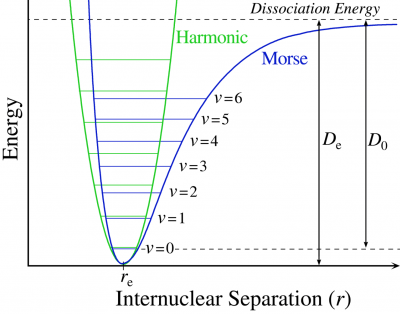PCh8 Lec2
Section 8.3 (cont.)
So, one of the things that we have not full acknowledged is that the harmonic oscillator potential of 1/kx2 is not really the actual potential...it is close, but not completely accurate. Figure 8.6 (similar to below) compares the 1/2kx2 potential to a potential referred to as the "Morse potential." The Morse potential is also referred to as an anharmonic potential. The Morse potential is one type of anharmonic potential, some fundamental research projects seek to refine the form of the "true" anharmonic potential.
If you recall originally solving the Schrodinger equation with the "harmonic" potential, the energy separation between the levels was the same, but with the Morse potential the energy result is slightly different leading to the energy levels getting closer together as we move up in the levels. Additionally, the harmonic potential did not acknowledge the fact that we can break the bond (the harmonic potential was infinitely high); the Morse potential takes bond breaking into account.
The following is taken from the "Morse potential wikipedia page"

